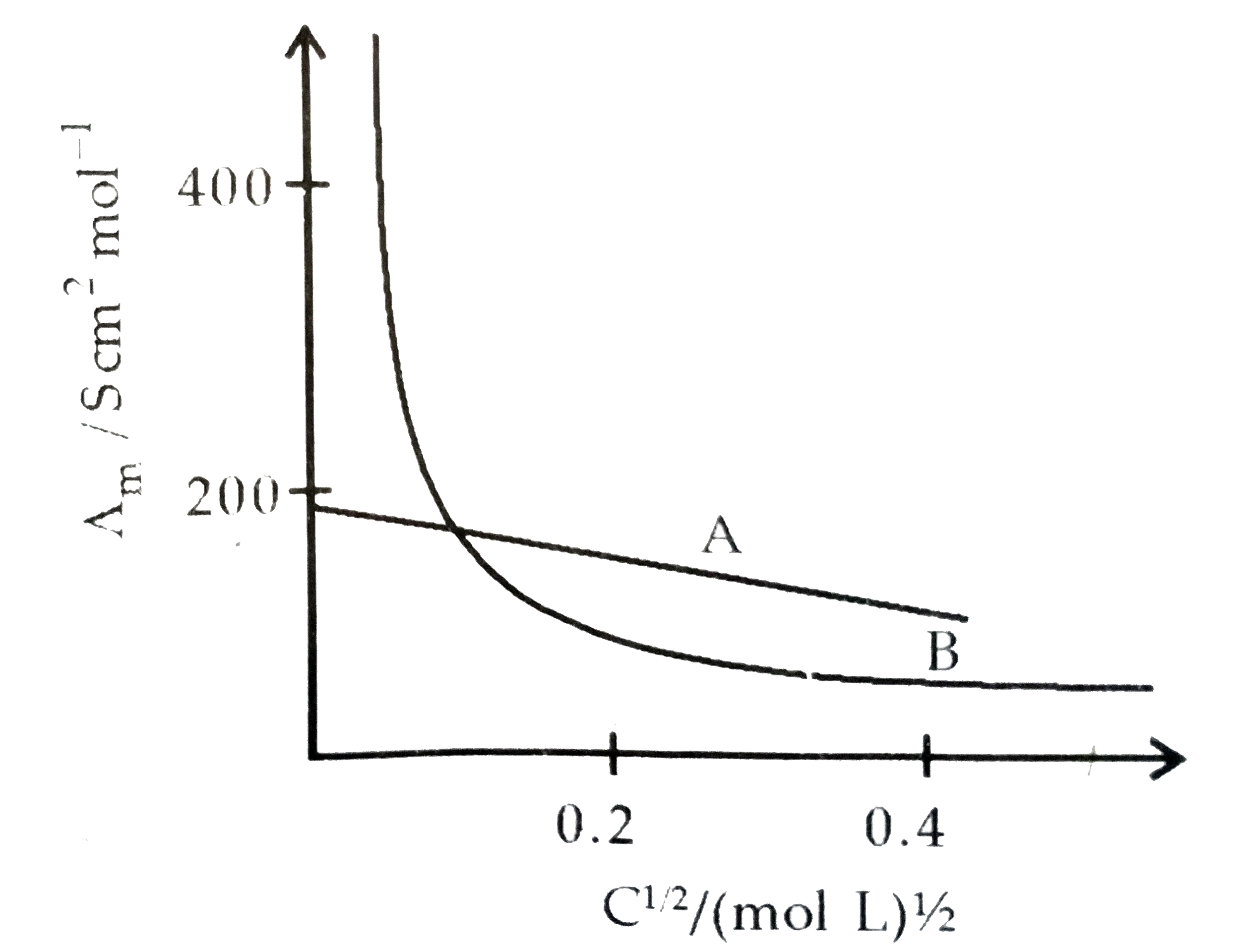The increase in the molar conductivity of HCl with dilution is due to
Increase in the self ionization of water
Hydrolysis of HCl
Decrease in the self ionization of water
Decrease in the interionic forces.
The correct Answer is:D
To solve the question regarding the increase in the molar conductivity of HCl with dilution, we can follow these steps:
1. Understanding Molar Conductivity:
Molar conductivity (Λm) is defined as the conductivity of an electrolyte solution divided by its molar concentration. It indicates how well an electrolyte can conduct electricity in solution.
2. Effect of Dilution:
When an electrolyte like HCl is diluted, its concentration decreases. According to the Debye-Hückel-Onsager equation, the molar conductivity of a strong electrolyte increases with dilution.
3. Ionization of HCl:
HCl dissociates completely in water into H+ and Cl− ions. When diluted, the number of water molecules increases, which can lead to a reduction in the interionic forces between the ions.
4. Interionic Forces:
In concentrated solutions, the ions are closer together, and the attractive forces between them can hinder their movement. As the solution is diluted, these interionic forces decrease, allowing the ions to move more freely.
5. Increased Mobility of Ions:
With the decrease in interionic forces, the mobility of H+ and Cl− ions increases. Higher mobility means that the ions can move more easily through the solution, which contributes to an increase in molar conductivity.
6. Conclusion:
Therefore, the increase in the molar conductivity of HCl with dilution is primarily due to the decrease in interionic forces, which enhances the mobility of the ions.
Final Answer:
The increase in the molar conductivity of HCl with dilution is due to the decrease in interionic forces.
---
Molar conductivity (Λm) is defined as the conductivity of an electrolyte solution divided by its molar concentration. It indicates how well an electrolyte can conduct electricity in solution.
When an electrolyte like HCl is diluted, its concentration decreases. According to the Debye-Hückel-Onsager equation, the molar conductivity of a strong electrolyte increases with dilution.
HCl dissociates completely in water into H+ and Cl− ions. When diluted, the number of water molecules increases, which can lead to a reduction in the interionic forces between the ions.
In concentrated solutions, the ions are closer together, and the attractive forces between them can hinder their movement. As the solution is diluted, these interionic forces decrease, allowing the ions to move more freely.
With the decrease in interionic forces, the mobility of H+ and Cl− ions increases. Higher mobility means that the ions can move more easily through the solution, which contributes to an increase in molar conductivity.
Therefore, the increase in the molar conductivity of HCl with dilution is primarily due to the decrease in interionic forces, which enhances the mobility of the ions.
The increase in the molar conductivity of HCl with dilution is due to the decrease in interionic forces.
Topper's Solved these Questions
- ELECTROCHEMISTRYBOOK - CENGAGE CHEMISTRY ENGLISHCHAPTER - ELECTROCHEMISTRYEXERCISE - Exerciseassertion -Reasoning
25 Videos
- ELECTROCHEMISTRYBOOK - CENGAGE CHEMISTRY ENGLISHCHAPTER - ELECTROCHEMISTRYEXERCISE - Exerciseinterger
8 Videos
- ELECTROCHEMISTRYBOOK - CENGAGE CHEMISTRY ENGLISHCHAPTER - ELECTROCHEMISTRYEXERCISE - Exercisemultiple Correct Ansers
53 Videos
- D AND F BLOCK ELEMENTSBOOK - CENGAGE CHEMISTRY ENGLISHCHAPTER - D AND F BLOCK ELEMENTSEXERCISE - Archives Subjective
29 Videos
- GENERAL PRINCIPLES AND PROCESS OF ISOLATION OF ELEMENTSBOOK - CENGAGE CHEMISTRY ENGLISHCHAPTER - GENERAL PRINCIPLES AND PROCESS OF ISOLATION OF ELEMENTSEXERCISE - Archives (Subjective)
14 Videos
Similar Questions
The increase in the value of molar conducitivity of acetic acid with dilution is due to
View SolutionThe following curve is obtained when molar conductivity (∧m) is plotted against the square root of concentration, c1/2 for two electrolytes A and B
(a) How do you account for the increase in the molar conductivity of the electrolyte A on dilution.

(b) As seen from the graph, the value of limiting molar conductivity (∧0m) for electrolyte B cannot be obtained graphically. How can this value be obtained?1
View Solution
Knowledge Check
Limiting molar conductivity of NaBr is
AΛ∘mNaBr=Λ∘mNaCl+Λ∘mKBrBΛ∘mNaBr=Λ∘mNaCl+Λ∘mKBr−Λ∘mKClCΛ∘mNaBr=Λ∘mNaOH+Λ∘mNaBr−Λ∘mNaClDΛ∘mNaBr=Λ∘mNaCl−Λ∘mNaBr
Define the term molar conductivity.
View SolutionDefine molar conductance
View SolutionThe increase in equivalent conductivity of a weak electrolyte with dilution is due to :
View SolutionThe molar conductivity of strong electrolyte
View SolutionCalculate molar conductivity of HCOOH at infinite dilution, if equivalent conductivity of H2SO4=x1, Al2(SO4)3=x2, (HCOO)3Al=x3
View SolutionMolar ionic conductivites of a bivalent electrolyte are 57 and 73. the molar conductivity of the solution will be
View SolutionThe molar conductivity of NH4Cl at infinite dilution is 149.7ohm−cm2mol−1 and ionic conductances of hydroxyl ions and chloride ions are 198 and 76.3 respectively. Calculate the molar conductivity of NH4OH at infinite dilution.
View Solution
